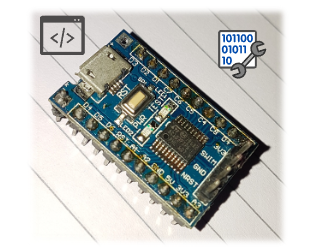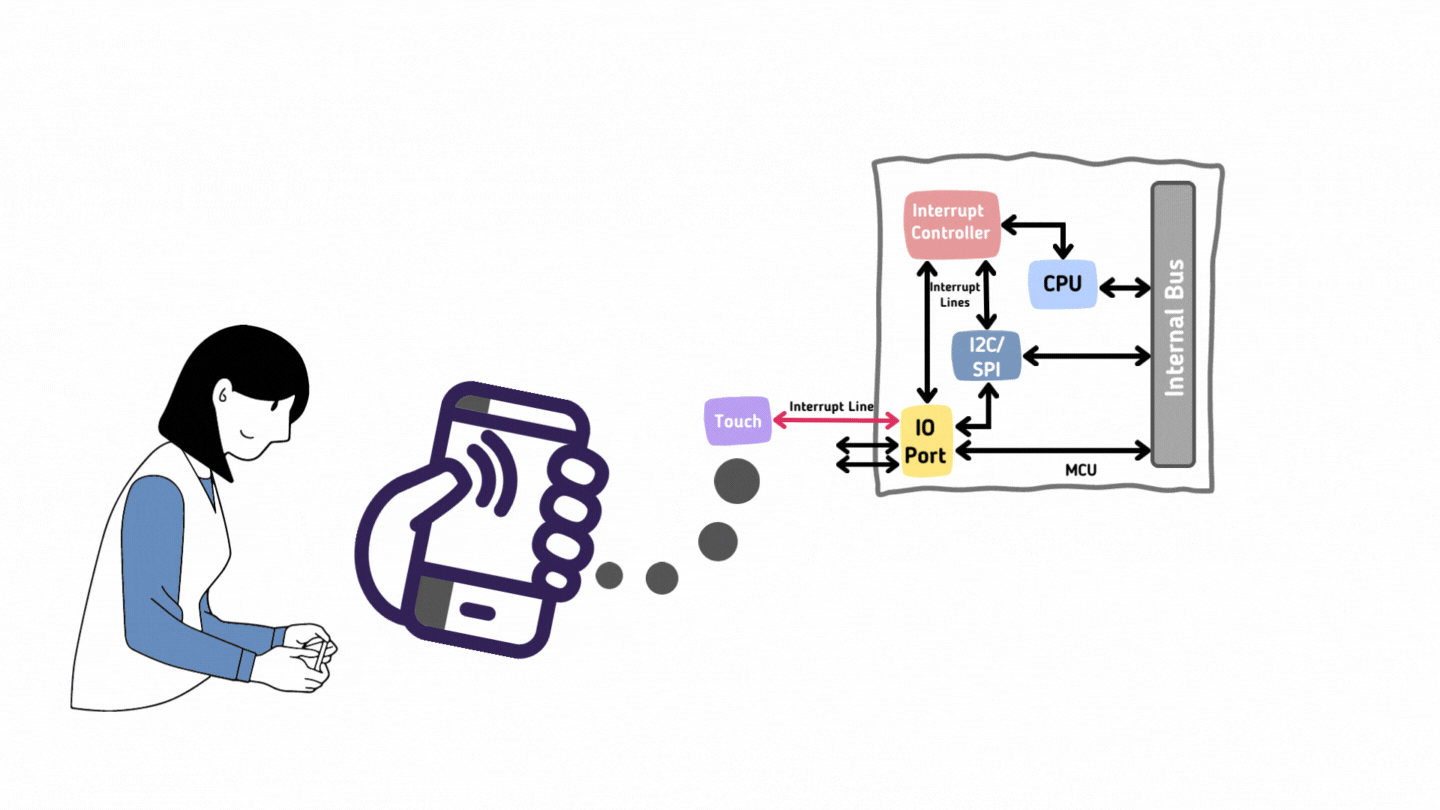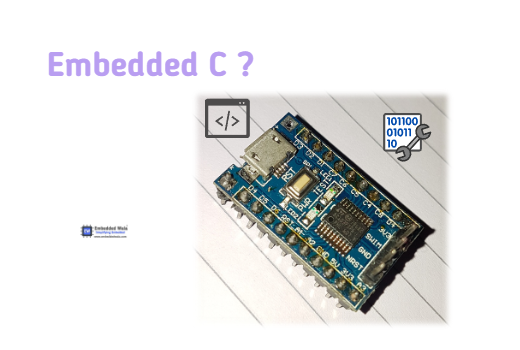
1. Introduction :
An embedded system refers to a computer system specifically designed to perform dedicated functions within a larger mechanical or electrical system. It combines both hardware and software components that are tailored to fulfill specific tasks or functions. Embedded systems are commonly found in various everyday devices and applications, including consumer electronics, automobiles, medical devices, industrial equipment, and more.
Embedded systems play a crucial role in enabling the functionality and intelligence of these devices. Engineers in the Embedded System field require expertise in electronics, computer engineering, and software development to design robust and efficient systems that meet the unique requirements of their applications. The prevalence of embedded systems is continuously expanding, driving advancements in automation, convenience, and efficiency in our interconnected world.
2. Features of Embedded Systems :
- Dedicated Functionality : They are built to serve specific purposes as required by the larger system they are a part of. They are customized to meet the unique requirements of the application they serve.
- Limited Resources : They typically operate with constrained resources such as limited processing power, memory, and storage. They are designed for efficiency and must work effectively within these resource limitations.
- Real-time Operation : Many embedded systems are designed to respond to events and perform tasks in real-time or within specific time constraints. They often interact with the physical world and must react promptly to external inputs.
- Hardware Interaction : They closely interact with hardware components and devices. They interface with sensors, actuators, communication modules, and other peripherals to control and monitor the external environment.
- Reliability and Safety : Embedded systems often operate in critical and safety-critical environments. They must be dependable, robust, and designed to avoid failures or hazards to ensure proper operation.
- Low Power Consumption : Many embedded systems are designed to operate on limited power sources such as batteries or energy-efficient systems. Power optimization techniques are crucial to prolong battery life or minimize power consumption.
- Deterministic Behavior : Meaning that they must consistently and predictably respond to inputs and events. This is crucial in applications where timing is critical, such as in real-time control systems or safety-critical environments.
- Communication and Networking : They frequently need to communicate with other systems or devices. This can involve wired or wireless communication protocols such as UART, SPI, I2C, Ethernet, Wi-Fi, Bluetooth, or cellular networks. Embedded systems may also integrate with higher-level networks, such as the Internet of Things (IoT) infrastructure.
- Security Considerations : Many embedded systems handle sensitive data or operate in environments where security is crucial. Security measures need to be implemented to protect against unauthorized access, data breaches, and malicious attacks. This includes techniques like encryption, authentication, secure boot, and secure firmware updates.
- Testing and Verification : Due to their critical nature, embedded systems require thorough testing and verification to ensure proper functionality and reliability. Testing techniques include unit testing, integration testing, system-level testing, and hardware-in-the-loop (HIL) testing. Safety-critical systems may also undergo rigorous certification processes.
- Software Development Life Cycle : They typically follow a specific software development life cycle, which includes requirements analysis, system design, software design, coding, testing, integration, and maintenance. Each stage requires careful consideration of the hardware-software interaction, performance optimization, and adherence to industry standards.
- RTOS and Bare-Metal Programming : They can be programmed using a Real-Time Operating System (RTOS) or using bare-metal programming. An RTOS provides an abstraction layer, scheduling capabilities, and resource management, making it easier to develop complex systems. Bare-metal programming involves directly interfacing with the hardware, offering more control but requiring greater expertise.
- Hardware Abstraction : To facilitate portability and reusability, embedded systems often employ hardware abstraction layers (HALs) or device drivers. These abstractions provide a standardized interface to interact with hardware peripherals, allowing software developers to focus on higher-level functionality without being concerned about low-level hardware details.

3. Types of Embedded Systems :
- Standalone Embedded Systems :
Independent devices that perform specific functions without the need for external connectivity. These systems operate in isolation and are commonly found in household appliances like microwaves, washing machines, and digital cameras. They are designed to provide localized functionality and do not require network connectivity.
- Real-Time Embedded Systems :
Real-time embedded systems are designed to respond to events and process data within strict time constraints. They are commonly used in applications that require immediate and deterministic responses, such as automotive systems, industrial control systems, and medical devices. Real-time embedded systems can be further classified into hard real-time systems, where missing deadlines can have severe consequences, and soft real-time systems, where occasional missed deadlines are tolerable.
- Networked Embedded Systems :
Networked embedded systems are connected to a network and communicate with other devices or systems. These systems enable seamless connectivity and data exchange, making them suitable for applications like home automation, smart grids, and industrial IoT (Internet of Things) solutions. Networked embedded systems rely on various communication protocols such as Ethernet, Wi-Fi, Bluetooth, or cellular networks to establish connections and transfer data.
- Mobile Embedded Systems :
Mobile embedded systems are designed for portable devices, such as smartphones, tablets, and wearable devices. These systems have unique power and size constraints and are optimized for energy efficiency and mobility. Mobile embedded systems often integrate sensors, wireless communication modules, and advanced user interfaces to provide a rich and interactive user experience.
- Embedded Systems for Critical Applications :
Used in critical applications demand a high level of reliability, safety, and fault tolerance. These systems are found in domains such as aerospace, defense, medical equipment, and nuclear power plants. They are designed with redundant components, advanced error detection and correction mechanisms, and rigorous testing and certification processes to ensure their reliable and secure operation.

4. Basic Structure of Embedded Systems :
- Processor/Controller : The processor or controller is the core component of an embedded system. It can be a microcontroller (MCU) or a microprocessor (MPU) that executes the instructions and controls the overall operation of the system. The choice of processor depends on factors like processing power, memory requirements, I/O capabilities, and cost.
- Memory : Embedded systems require different types of memory to store program instructions, data, and variables. This includes ROM (Read-Only Memory) or Flash memory for storing the firmware or software code, RAM (Random Access Memory) for temporary data storage during runtime, and non-volatile memory for long-term data storage.
- Input/Output (I/O) Devices : Embedded systems interact with the external environment through various input and output devices. These can include sensors to measure physical quantities, actuators to control external devices, displays for user interface, communication interfaces like UART, SPI, I2C, Ethernet, USB, and more. The I/O devices enable the system to sense and respond to the surrounding environment.
- Power Supply : Embedded systems require a power source to operate. This can be a battery, AC power supply, or other energy sources depending on the application requirements. Power management techniques are often employed to optimize power consumption and extend battery life in portable devices.
- Real-Time Clock (RTC) : Many embedded systems require accurate timekeeping for scheduling tasks, timestamping events, or maintaining system synchronization. A real-time clock (RTC) is a dedicated component that provides time and date information to the system.
- Communication Interfaces : Embedded systems often need to communicate with other devices or systems. This can be achieved through various communication interfaces such as UART, SPI, I2C, Ethernet, wireless protocols (Wi-Fi, Bluetooth, Zigbee), and more. Communication interfaces enable data exchange, networking, and connectivity.
- Software/Firmware : Embedded systems run software or firmware code that controls their behavior. This code is responsible for executing specific functions, interacting with hardware components, handling input/output operations, and implementing the desired functionality of the system. The software is typically developed using programming languages like C, C++, or Rust, and may include real-time operating systems (RTOS) or bare-metal programming.
5. Use Cases of Embedded Systems
- Consumer Electronics : Embedded systems are extensively used in various consumer electronics such as smartphones, tablets, smart TVs, wearables (smartwatches, fitness trackers), and home automation systems. They provide functionality, connectivity, and user interaction, enabling features like touchscreens, voice assistants, and internet connectivity.
- Automotive : These systems play a crucial role in automotive applications, powering engine control units (ECUs) for monitoring and controlling engine functions, infotainment systems for audio/video playback and navigation, advanced driver-assistance systems (ADAS) for safety features, and in-vehicle networking for component integration.
- Industrial Automation: They are vital for controlling and monitoring machinery, robots, and process control systems in industrial settings. They enable precise control, data acquisition, and communication between different components, facilitating automation and efficiency.
- Medical Devices : These systems ensure accurate and reliable operation in medical devices such as patient monitoring systems, implantable devices, diagnostic equipment (MRI, CT scanners), and medical imaging systems. They enable real-time data acquisition, analysis, and control.
- Aerospace and Defense : They are extensively used in flight control systems, avionics, satellite communication systems, radar systems, and missile guidance systems in the aerospace and defense industries. These systems require high reliability, real-time response, and robustness.
- Smart Grids and Energy Management : These systems facilitate control and monitoring of power distribution systems, energy meters, renewable energy systems, and efficient energy management. They optimize energy consumption, improve grid stability, and enable advanced metering and billing systems.
- Internet of Things (IoT) : These systems connect physical objects to the internet, enabling data collection, analysis, and control in various domains like smart cities, agriculture, healthcare, and home automation.
- Security Systems : They power surveillance cameras, access control systems, alarm systems, and biometric authentication devices in security applications.
- Transportation and Logistics : They enable traffic management systems, fleet management systems, GPS navigation devices, and tracking systems in transportation and logistics applications.
- Communication Systems : They are used in routers, modems, network switches, and wireless devices for reliable and efficient data transmission and network management.
6. Programming Languages For Embedded Systems :
Programming typically involves using specialized languages like sometimes Assembly, C or C++, as well as low-level hardware interfaces and protocols. Developers must possess a deep understanding of the hardware, real-time constraints, and specific domain requirements to design, develop, and deploy reliable and efficient embedded systems. By leveraging their knowledge of hardware interactions and resource limitations, embedded system developers create software that seamlessly integrates with the underlying hardware, enabling the system to perform its dedicated functions effectively and reliably.
7. Operating Systems for Embedded Systems :
Operating systems provide the necessary software infrastructure to manage hardware resources, enable communication between components, and support application development. Here are some common operating systems used in embedded systems:
- FreeRTOS : FreeRTOS is a popular open-source real-time operating system (RTOS) designed for small embedded systems. It is known for its small footprint, low overhead, and efficient task scheduling, making it suitable for resource-constrained devices.
- ThreadX : ThreadX is a widely-used commercial real-time operating system known for its small memory footprint, fast context switching, and deterministic real-time response. It offers features like priority-based scheduling, inter-thread communication, and synchronization mechanisms.
- µC/OS-II and µC/OS-III : µC/OS-II and µC/OS-III are small, highly portable, and scalable real-time kernels from Micrium. They provide task scheduling, inter-task communication, synchronization primitives, and memory management for embedded systems.
- Linux : Linux, with its versatility and wide community support, is increasingly used in embedded systems. Lightweight distributions like Embedded Linux, Buildroot, and Yocto Project are customized for specific hardware platforms and offer a range of features such as device drivers, networking, filesystems, and user-space libraries.
- VxWorks : VxWorks is a real-time operating system commonly used in safety-critical and high-reliability systems. It provides deterministic real-time performance, fault tolerance, and a rich set of features for embedded systems in industries like aerospace, defense, and industrial automation.
- QNX : QNX is a commercial real-time operating system known for its robustness, reliability, and scalability. It offers features like process management, inter-process communication, and fault tolerance, making it suitable for embedded systems in industries such as automotive and medical devices.
- RTEMS : RTEMS (Real-Time Executive for Multiprocessor Systems) is an open-source real-time operating system designed for embedded systems. It supports a wide range of processors and offers features like task scheduling, inter-task communication, and filesystems.
- Nucleus RTOS : Nucleus RTOS is a widely-used commercial real-time operating system offering a small footprint, efficient task scheduling, and a comprehensive set of features for embedded systems. It supports various processor architectures and provides kernel-level services for memory management, inter-task communication, and device drivers.
8. Conclusion :
Embedded systems are crucial in multiple industries as they enable automation, real-time monitoring, and seamless communication, resulting in enhanced efficiency, accuracy, and reliability. This leads to increased productivity and improved user experiences. Embedded systems possess versatility, enabling devices to perform specialized tasks, handle complexity, and connect to networks. Ongoing advancements continuously enhance the power and energy efficiency of embedded systems. As industries embrace connectivity and undergo digital transformation, the demand for innovative solutions grows, driving further advancements and applications. In conclusion, embedded systems are indispensable components of modern technology, promoting automation and facilitating connectivity across various industries.



